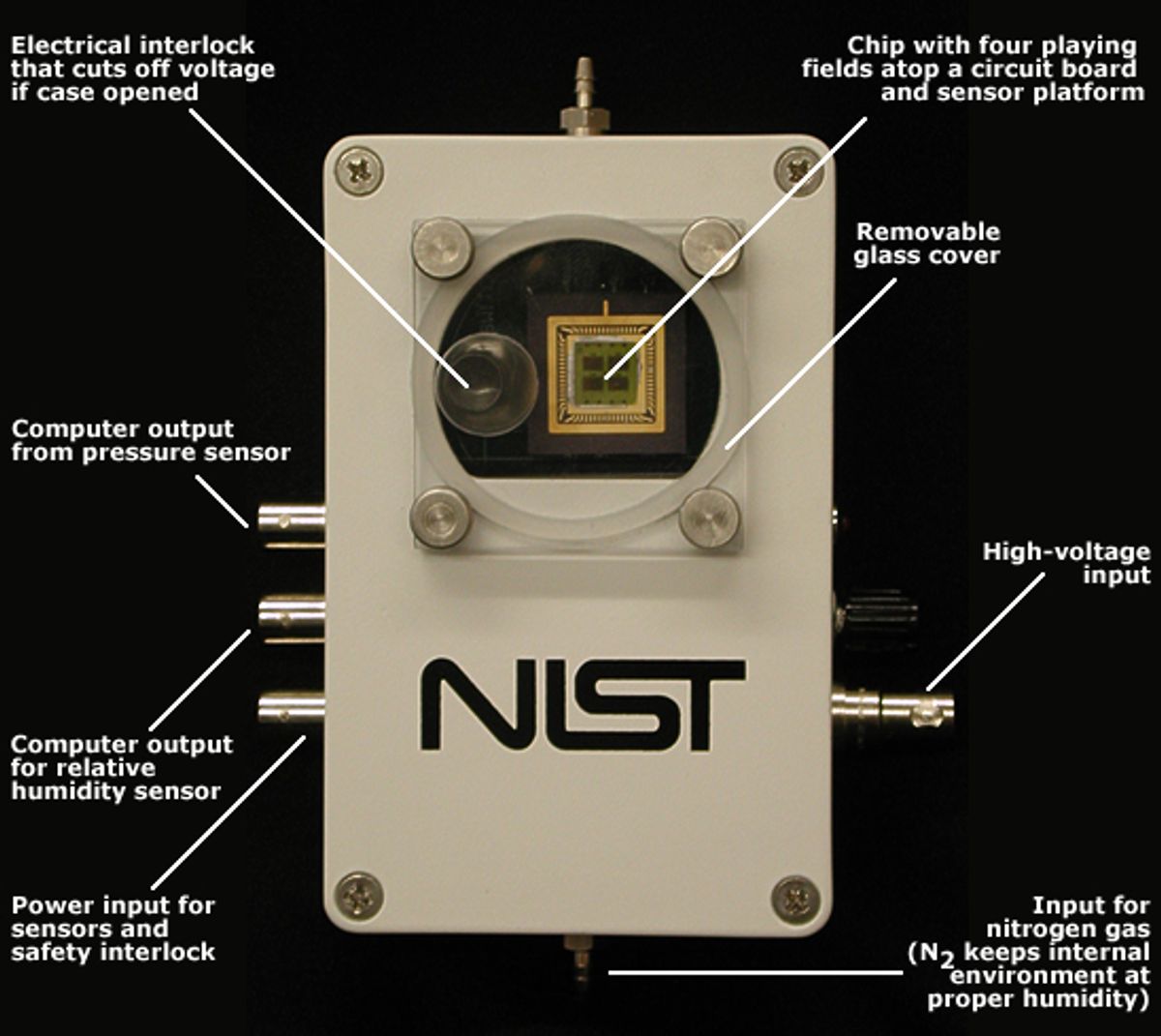This is the microrobotics competition arena. Image: NIST
At the IEEE International Conference on Robotics and Automation, in Anchorage, Alaska, this week, the U.S. National Institute of Standards and Technology, the famed NIST, is holding a robotics competition for small robots -- very small robots.
In the Mobile Microrobotics Challenge, robots with dimensions measured in micrometers will square off in a series of challenges taking place at a, uh, microchip playing field [photo above]. First there's a race across a 2 millimeter distance, or the equivalent to the diameter of a pin head. Then the microbots will compete in a microassembly challenge in which they'll have to insert tiny pegs into tiny holes. Finally, there's a freestyle competition in which each team chooses how to show off its small bot in a grand way.
Researchers will remote operate the microrobots, viewed under a microscope, using magnetic fields or electrical signals transmitted across . The bots, made from materials like silicon, gold, aluminum, nickel, and chromium, are a few tens of micrometers to a few hundred micrometers across and weigh just a few nanograms.
As the organizers put it, "These events are designed to 'road test' agility, maneuverability, response to computer control and the ability to move objects—all skills that future industrial microbots will need for tasks such as microsurgery within the human body or the manufacture of tiny components for microscopic electronic devices."
Here's a schematic of the 2 millimeter racetrack:
And here are the contenders:
Team Name: Magic & Voodoo
Organization: Carnegie Mellon University (Pittsburgh, Pennsylvania)
Robot Dimensions: Under 500 micrometers in all dimensions
Materials: Neodymim-Iron-Boron magnetic particles suspended in a polyurethane matrix material
Team Name: CNRS Team (The French Team)
Organization: FETO-ST Institute; ISIR - Institut des Systemes Intelligents et de Robotique (France)
Robot Dimensions: Under 400 micrometers in all dimensions
Materials: The MagPieR microrobotis composed of two distinct layers, an upper using a ferromagnetic metal (such as nickel) and a lower using a piezoelectric material.
Team Name: MagMite Team
Organization: ETH Zurich (Switzerland)
Robot Dimensions: Under 300 micrometers in all dimensions
Materials: The device consists of two nickel masses connected through a gold spring.
Team Name: Stevens Institute of Technology
Organization: Stevens Institute of Technology (Hoboken, New Jersey)
Robot Dimensions: Under 600 micrometers in all dimensions
Materials: Nickel, copper
Team Name: University of Maryland
Organization: University of Maryland (College Park, Maryland)
Robot Dimensions: 500 micrometers in all dimensions
Materials: The device is silicon cube with a layer of nitride on the top surface, and platium on the bottom
(ElectroMagnetic Microrobotic Actuation)
Team Name: University of Waterloo Nanorobotics Group
Organization: University of Waterloo (Canada)
Robot Dimensions: 500 micrometers and under in all dimensions
Materials: Nickel, cobalt, manganese, phosphorus
Team Name: U.S. Naval Academy Microrobotics Team
Organization: U.S. Naval Academy (Annapolis, Maryland)
Robot Dimensions: 300 micrometers in diameter
Materials: Nickel, gold, polysilicon, nitride
We'll keep you updated about the competition and winners, and try to get some video as well.
Images: NIST
Erico Guizzo is the Director of Digital Innovation at IEEE Spectrum, and cofounder of the IEEE Robots Guide, an award-winning interactive site about robotics. He oversees the operation, integration, and new feature development for all digital properties and platforms, including the Spectrum website, newsletters, CMS, editorial workflow systems, and analytics and AI tools. An IEEE Member, he is an electrical engineer by training and has a master’s degree in science writing from MIT.












